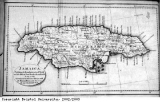West Indies
Europeans first ‘discovered’ the Caribbean and the ‘New World’ when Christopher Columbus landed on the Bahamas (a group of islands on the northwest edge of the Caribbean) in 1492. Over the next 100 years, the islands and the east coast of mainland America were settled by Europeans. They were farming the land, growing crops at first for food, then later for luxury crops to be sold. On the islands, the local people were made to work the land by the invading Europeans. But they were unused to the diseases brought by the Europeans, and quickly died out due to disease, overwork and harsh treatment, and fighting the new settlers.
The Europeans had productive plantations but no-one to work them. They brought indentured labourers and transported prisoners from home, but this was not sufficient. As big plantation owners forced out small landowners and started growing labour-intensive sugar, the demand for labour was met by buying African slaves. In 1639 there were 1,000 Africans on the Caribbean island of Barbados. The ‘sugar revolution’ increased that number to 52,000 by 1666.



